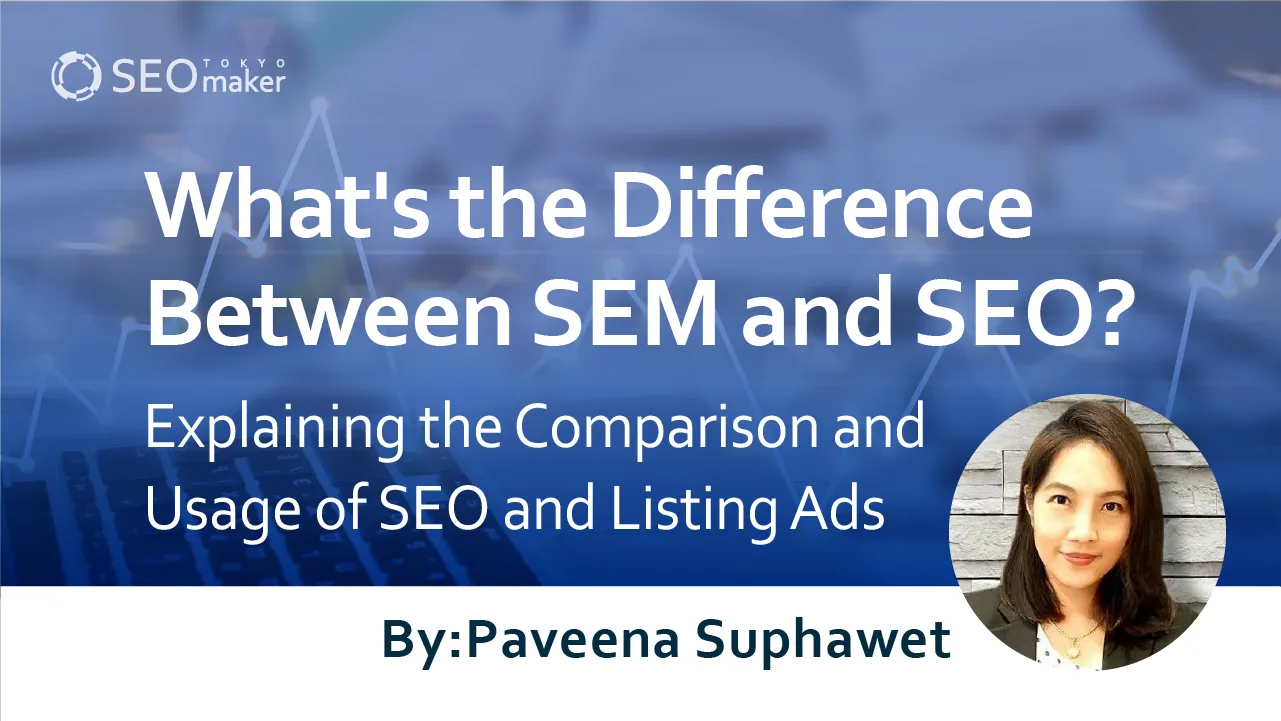What’s the Difference Between SEM and SEO? Explaining the Comparison and Usage of SEO and Listing Ads
contents

As a similar term to SEO, there’s a web strategy known as SEM. Both SEO and SEM share common ground in being strategies aimed at search engines and web marketing, making their terminology closely related. Hence, distinguishing between SEM and SEO can sometimes be challenging , leading to occasional confusion.
Firstly, SEM stands for Search Engine Marketing, which refers to marketing strategies on the web. Typically, when running a website, the aim is to maximize effectiveness concerning set objectives. In such cases, introducing SEM strategies to address both SEO and listing advertisements enhances access efficiency.
Tokyo SEO consult Maker, a specialist in SEO, provides insight into SEM. They not only explain the differences between SEM and SEO but also elucidate their relationship with listing ads in an understandable manner. Additionally, they introduce how to proceed with SEM strategies, providing concrete examples.
What is SEM?
SEM, or Search Engine Marketing, refers to web marketing utilizing search engines . By leveraging SEO and listing advertisements to attract traffic to a website, it’s possible to increase site visitors and enhance sales and promotional effects.
Reasons for the Emphasis on SEM
SEM is emphasized due to the extensive user base of search engine services.
In recent years, with the proliferation of smartphones and tablet devices, there has been an increase in internet users compared to the desktop era.Moreover, with internet usage becoming commonplace, the use of search engines has also expanded, with search engines being utilized in various aspects from daily life to business.
Against this backdrop, businesses utilizing websites have been steadily increasing. As we examined, there has been a growing trend towards monetizing websites and increasing opportunities for promoting company products on websites.
In such a landscape, SEM strategies utilizing SEO and listing advertisements have gained attention as marketing methods.
Difference Between SEM and SEO
The difference between SEM and SEO lies in the target of the strategies. SEM refers to web marketing using search engines, positioning SEO as a component of SEM strategies.
In other words, SEM strategies can be divided into two types:
-SEO Measures
-Listing Advertisements
What are SEO Measures?
SEO, or Search Engine Optimization, aims to optimize search engine results organically by targeting specific keywords. By achieving higher rankings in search results, directing users search to the website becomes feasible.
SEO measures include
-Content SEO
-Internal SEO
-External SEO
Content SEO
Content SEO refers to search engine optimization measures that enhance the quality of content within a website . It is precisely categorized as a type of internal SEO strategy.
Criteria for high-quality content include:
-Content that is highly relevant to the theme of the website
-Content that satisfies search users
-Content that includes original elements
By increasing the number of quality articles related to the website’s theme and further encompassing it, Google recognizes the website as having high expertise on the theme. This also benefits in higher site navigation rates by visitors.
In recent years, content SEO has garnered significant attention. Both internal and external SEO strategies are effective on the premise that there is quality content. It is a common pitfall to hear about cases where too much emphasis is placed on internal and external strategies or design planning, leaving no time to create content. Without preparing content, it is impossible to even start achieving the purpose of setting up the site.
Related article: What is Content SEO?
Internal SEO
Internal SEO involves organizing website structures to facilitate understanding by search engines and users. This includes
-Directory Configuration
-Normalization of URLs and setting of permalinks
-Optimization of HTML and CSS tags
-Optimization of internal links
Advancing internal SEO measures can make it easier for your website to be correctly evaluated by search engines. Moreover, by appropriately revising the site, the convenience of the website itself increases, enhancing the satisfaction of search users. Consequently, the time spent by visitors on the site and the rate of return visits naturally rise, creating a positive spiral.
offline, neglecting internal measures can give the impression of a website that is difficult to use for both search engines and users. Especially, if the site structure is disorganized, content duplication within the website can occur, leading to factors that lower search rankings.
Related article: A detailed explanation of internal SEO measures (On-Page SEO)
External SEO
External SEO utilizes external environments for SEO purposes. Effective strategies include
-Link-building initiatives
-Citations
-Social media efforts.
Among these, link-building is the most effective method. For instance, links from external sites to a company’s website improve its SEO evaluation. Search engines recognize content as “referenced by external sites,” which can lead to an increase in search rankings.
Examples of external link strategies include:
-Linking from your corporate site to your own product brand site
-Creating articles for collaborative projects and negotiating for backlinks
On the other hand, there are SEO practitioners who sell links for money because of the high effectiveness of backlinks. However, Google prohibits the buying and selling of links. Purchasing links for SEO purposes can result in penalties from Google, so you should never buy backlinks.
Related article: What are external SEO strategies?
Listing Ads
Listing ads, also known as search-linked ads, are text-based web advertisements displayed in search engine results.
As shown in the above image, listing ads may appear higher in search results than organic search results. Therefore, even without dedicating time to SEO strategies, you can expect traffic from search engines. Additionally, listing ads are pay-per-click (PPC ) advertisements, where costs accrue based on the number of clicks. PPC advertising offers advantages such as easy control over advertising budgets.
Related Articles: What are Listing Ads?
Related Articles: What is PPC Advertising?
Comparing the Strengths of SEO and Listing Ads
The table below compares the strengths of SEO and listing ads.
| SEO | Listing Ads | |
| Cost | Not required | Required |
| Click-through Rate | High | Low |
| Control | Difficult | Easy |
| Immediate Effect | ||
| Low | High | |
| Sustainability | High | Low |
About the Cost of SEO and Listing Ads
SEO strategies generally do not incur costs. However, expenses may arise in the following cases:
-Outsourcing SEO strategies
-Increasing the team responsible for SEO tasks
The former involves outsourcing SEO strategies to external SEO companies, while the latter pertains to deploying or hiring new employees for in-house SEO tasks.
On the other hand, listing ads entail advertising costs, in addition to requiring personnel expenses similar to SEO strategies.
About the Click-through Rate of SEO and Listing Ads
Web pages displayed prominently through SEO strategies are more likely to be clicked by search users, effectively increasing traffic flow . Particularly, achieving the top position in search results can result in a 20-30% influx of search users.
offline, web pages displayed as listing ads face the challenge of low click-through rates . This is because search users tend to intentionally avoid ads. The click-through rate is typically around 5% even at its highest.
About the Control of SEO and Listing Ads
In SEO strategies, placing web pages in intended positions is challenging . Ultimately, search engines determine organic search results. Therefore, achieving visibility for one’s own page in search results requires advanced knowledge of SEO.
In contrast, with listing ads, paying the advertising fee ensures placement in search results. Furthermore, it’s easier to control ad displays, and you can change ad delivery start and stop times at any time.
About the Immediate Effect of SEO and Listing Ads
SEO strategies may take a long time, depending on the keywords, to achieve top rankings. It can take six months to a year before the effects of SEO strategies become apparent.
On the other hand, listing ads can be displayed immediately.
About the Sustainability of SEO and Listing Ads
Pages displayed prominently through SEO strategies generally maintain their effectiveness over time. However, in reality, changes in search engine algorithms may cause fluctuations in search rankings. Moreover, in the case of highly competitive keywords, continuous rewriting of web pages is necessary to maintain search rankings.
In contrast, discontinuing listing ad placements immediately diminishes their effectiveness.
Differentiating Between SEO and Listing Ads
Employing the strengths of both SEO strategies and listing ads enhances their effectiveness. Additionally, combining SEO strategies and listing ads (i.e., SEM) can yield even better results.
Cases Where SEO Strategies are Effective
Launching a web media platform is an example of when SEO strategies are suitable.
When launching a web media platform, the goal is to deliver basic information and the latest news related to the theme. In this case, nurturing the website over the medium to long term is essential. As the website continues to operate, the number of pages increases, and the comprehensiveness of the site’s theme improves. Furthermore, if your company has high expertise in the site’s theme, you can publish original content not found on other sites. This accumulation is crucial for enhancing SEO evaluation. Therefore, when launching a web media platform, incorporates SEO strategies.
Examples of Effective Listing Ads
One effective use case for listing ads is setting up landing pages to announce new products, among other scenarios.
Related Article: What is a Landing Page?
In this context, a landing page refers to a standalone web page set up with the aim of directing users to conversion pages. However, since the goal is to attract traffic over a short period , there is a challenge in expecting SEO effects. Hence, listing ads, which are compatible with web advertising, are frequently used in such cases.
Approach to SEM Strategies
The approach to SEM strategies is as follows:
1. Set objectives
2. Determine target users and keywords for attracting traffic
3. Measure advertising effectiveness
We will introduce this flow with specific examples. In this case, we will discuss scenarios such as:
-Selling anti-aging cosmetics
-Having a product brand site
-Increasing product sales
Set Objectives
In this case, the ultimate objective is to increase sales of anti-aging cosmetics. Furthermore, specific goals will be set to achieve this objective.
In SEM strategies, listing ads will be placed. Therefore, the “objective” here refers to the Cost per Acquisition (CPA) . CPA refers to the cost of acquiring one customer. If advertising costs exceed product sales, it will result in a loss .Therefore, to aim for profitability, it’s necessary to set a target value for CPA.
Related Article: What is CPA?
- Determine Target Users and Keywords
Determine the users to attract. In this case, the ultimate goal is to increase sales of anti-aging cosmetics. In that case, it becomes clear that the main target, “women after adulthood,” should be attracted.
Considering the nature of the main target audience, keywords will be determined as follows:
– Identify preferred catchphrases
– Identify existing search needs
For anti-aging cosmetics, keywords related to problem-solving are searched. Therefore, in this case, candidate keywords could be:
-Women wrinkles
-20s skin
- Measure Advertising Effectiveness
After a certain period, measure the effectiveness of listing ads. In measuring effectiveness, check if the target CPA value has been achieved. If the CPA target is not met, the following issues may be anticipated:
-Inappropriate keywords set for advertising
-Low quality of product introduction page
-Lack of appeal in the product itself
Once the cause of not reaching the goal is identified, take one of the following measures:
-Change keywords
-Improve the quality of the product introduction page
-Stop listing ad distribution
Frequently Asked Questions About SEM
We have compiled frequently asked questions about SEM.
Q: What is SEM an abbreviation for?
A: SEM is an abbreviation for Search Engine Marketing, a term used in web marketing.
Q: How is SEM translated into Japanese?
A: SEM is translated as Search Engine Marketing
Q: What are SEM ads?
A: SEM ads refer to listing ads and display ads displayed on search engines.
Q: Are there any useful tools for SEM strategies?
A: Semrush is a useful tool for deploying SEM strategies.
Semrush not only supports SEO measures but also allows for the measurement of web advertising and SNS effects. It is a tool used by marketers worldwide.
Related Article: What is Semrush? Explaining the features and usage of Semrush
Q: What is the difference between SEM and listing ads?
A: SEM refers to web marketing using search engines. Therefore, both SEO measures and listing ads are part of SEM strategies.
Summary
SEM, or Search Engine Marketing, includes SEO measures and listing ads as part of web marketing using search engines. First, understand the strengths and weaknesses of SEO and listing ads. For example, SEO measures are suitable for cases where plans are made to nurture websites over the medium to long term. On the other hand, listing ads are useful when immediate traffic is desired. Depending on your company’s objectives, using SEO measures and listing ads appropriately is key to achieving results with each strategy.










![What is a Description? Explaining the Meaning, Writing Style, and Changing Word Count – [2023 Edition]](https://www.switchitmaker2.com/en/wp-content/uploads/2024/09/what-is-description.webp)










